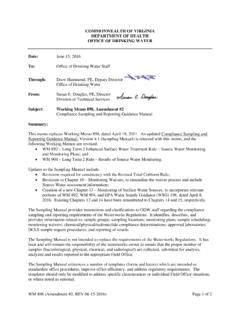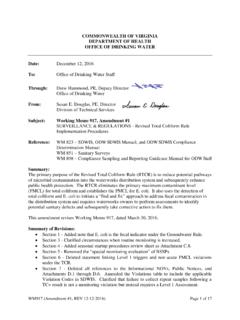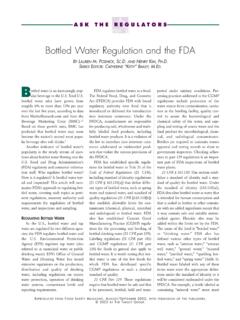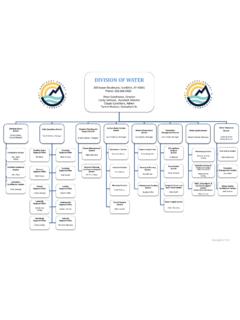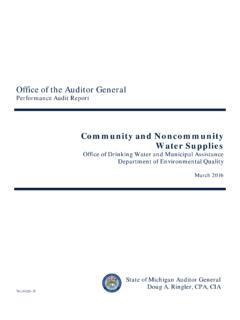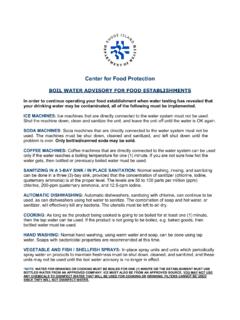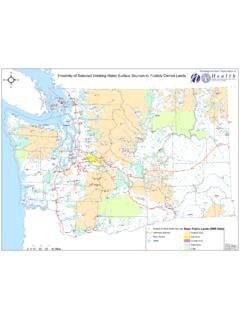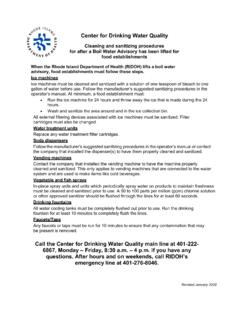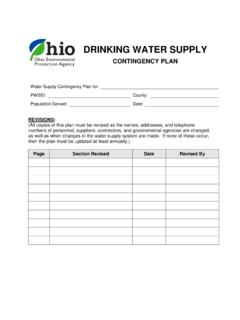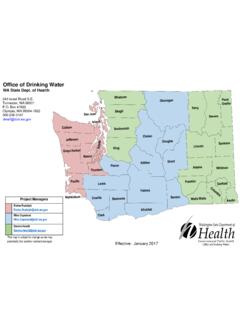Transcription of Michigan Department of Environmental Quality Office of ...
1 FACT SHEET. Michigan Department of Environmental Quality Office of drinking water and Municipal Assistance What are Coliform Bacteria? What are the Effects of Coliform Bacteria Coliform bacteria are commonly found in soil, on Most coliform bacteria do not cause illness. vegetation, and in surface water . They also live in However, their presence in a water system is a the intestine of warm-blooded animals. Because public health concern because of the potential for coliform bacteria are most commonly associated disease-causing strains of bacteria, viruses, and with sewage or surface waters, they are used as an protozoa to also be present. Waterborne disease indicator group to determine the sanitary Quality of from these organisms typically involves flu-like drinking water . One particular type of coliform symptoms such as nausea, vomiting, fever, and organism, called E. coli, is an indicator of fecal diarrhea. contamination.
2 Some coliform bacteria strains can survive in soil and water for long periods of time. In 1999, a strain of coliform bacteria called The routine coliform test performed by the Michigan E. coli 0157:H7 from animal yard runoff entered a Department of Environmental Quality (MDEQ) poorly constructed water supply well and resulted in Laboratory detects both fecal and nonfecal coliform two deaths and over 1,000 cases of illness at a bacteria. Bacterial contamination cannot be county fair in New York. Canada's most serious detected by taste, smell, or sight. waterborne disease outbreak occurred in Walkerton, Ontario in 2000. E. coli and Bacteria washed into the ground by rainfall or Campylobacter jejuni from manure spread on a snowmelt are usually filtered out as water seeps farm near the town entered a well that supplied the through the soil. Properly constructed water wells town's public water supply. The outbreak resulted do not typically harbor coliform bacteria.
3 Coliform in seven deaths and 2,300 people suffered from the bacteria do not occur naturally in Michigan aquifers. symptoms. (Fractured or creviced bedrock aquifers that are close to the surface are the exception). They can Coliform Bacteria Study be introduced into a new well during construction and can remain if the water system is not In response to a high number of water wells that thoroughly disinfected and flushed. tested positive for coliform bacteria following a 1993 Midwest flood, the Centers for Disease Coliform bacteria can persist within slime formed by Control (CDC) conducted a study in 1994. naturally occurring groundwater microorganisms. water wells at 5,520 houses in nine states were The slime (or biofilm) clings to the well screen, surveyed and sampled. The 6-month long study casing, drop pipe, and pump. Disturbances during revealed that water supply wells at the highest pumping or well maintenance can cause the slime risk for coliform bacteria contamination were: to dislodge, releasing the coliform bacteria.
4 Dug/Bored Wells Well construction defects such as insufficient well casing depth, improper sealing of the space Brick/Rock/Concrete Wells between the well casing and the borehole, corroded or cracked well casing, and poor well seals or caps Wells in Pits can allow sewage, surface water , or insects to carry coliform bacteria into the well. Unplugged Source: A Survey of the Quality of water Drawn abandoned wells can also carry coliform bacteria from Domestic Wells in Nine Midwest States, into deeper aquifers. CDC, September 1998. EQC 2073a (10/2013). Detecting Coliform Bacteria How Can I Eliminate Coliform Bacteria? All drinking water wells should be tested at least If coliform organisms are present, the source of annually for coliform bacteria. Michigan 's well the problem should be identified. Resampling construction code requires that all new, repaired, or from several locations within the water system is reconditioned wells be disinfected with chlorine to kill helpful.
5 Bacteria that may have been introduced during construction. Testing is required initially to The entire water system may need to be demonstrate that the water is free of coliform thoroughly flushed and redisinfected before a bacteria before the well is put into service. A negative bacteria sample can be obtained. coliform bacteria test is also recommended Sometimes it is necessary to repeat the immediately if: disinfection process. A water well drilling contractor or local health Department sanitarian A sudden change occurs in your water 's taste, can help identify structural defects in the system. appearance, or odor. These include: openings at the top of the well; old, The water turns cloudy after rainfall or the top of rusty, or damaged well casing; unprotected the well was flooded. suction line; buried wellhead; and close proximity You suspect a contamination source ( , septic of a well to septic tanks, drainfields, sewers, system or barnyard) is within 50 feet of your well.
6 Kitchen sinks, drains, privies, barnyards, animal Family members are experiencing unexplained feedlots, abandoned wells, and surface water . flu-like symptoms. Cross-connections with wastewater plumbing can also introduce coliform bacteria into the water Be sure to use proper sampling techniques while supply. If any of the above are found, proper taking the sample. Human error in sampling can changes or repairs should be made. After the cause positive sample results. Refer to the defects are corrected the entire water system instructions that accompany the water sample should be disinfected and the water retested container. A clean, well-maintained, and frequently before drinking . used faucet should be used to collect the sample. Old, rusty, leaky, rarely used, or swing-type faucets The MDEQ does not recommend continuous can lead to a positive result and are not chlorination as a substitute for proper well design recommended.
7 And construction. Keep in mind that coliform organisms do not always Some local health departments collect water show up in every sample. They are sporadic and samples as part of their permitting/inspection sometimes seasonal when they occur in a water process for new wells. Others rely on well owners supply. to collect the samples. Your local health Department can furnish sample containers or can Be concerned but do not panic if coliform bacteria provide a list of private laboratories that offer state are detected. Before treating, repairing, or replacing certified drinking water testing. the well, it is wise to resample immediately if a FOR ASSISTANCE. positive sample is collected. If you receive a second Contact your local health Department or: positive sample for total coliforms, or if the initial Michigan Department of Environmental Quality sample is positive for fecal coliforms, do not Office of drinking water & Municipal Assistance consume the water .
8 You may want to consider Environmental Health Section 525 West Allegan using bottled water as a temporary potable source. PO Box 30241. Bringing the water to a rolling boil for three minutes Lansing, MI 48909-7741. will kill the bacteria. Phone: 517/284-6542. Fax: 517/241-1328. Internet: Environmental Assistance Center: 1-800-662-9278.
